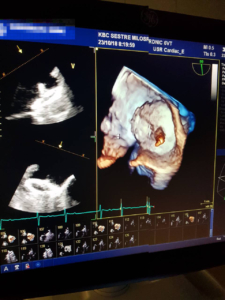Patients with atrial fibrillation have an increased risk of stroke. The risk depends on other illnesses that patients have and can be up to 10 times higher than people without atrial fibrillation. Therefore, patients with atrial fibrillation, depending on the risk, have to permanently take anticoagulation therapy (novel oral anticoagulants or warfarin) in order to reduce the risk of stroke.
However, a small quantity of patients have experienced significant bleeding before or after starting anticoagulation therapy (primarily, intracranial and major non-preventable gastrointestinal bleeding).
With these atrial fibrillation patients, as a method of reducing stroke risk, left atrial appendage occlude could be used. Left atrial appendage is the area where clots occur during atrial fibrillation which are the source of systemic thromboembolism including stroke. With a special device (Figure 1) that “closes” the appendage and excludes it from the circulation, the risk of thromboembolism and stroke is significantly reduced, and after a certain period of time anticoagulation therapy is discontinued, consequently reducing the risk of bleeding.
Figure 1 (source:aubmc.org)
The procedure is performed under local anaesthesia and sedation under the control of X-ray (Figure 3) and transoesophageal echocardiography (Figure 2). A special introducer goes from the right to the left atrium and, depending on the characteristics of the appendage, a occlude-device of a certain size is placed.
Figure 2
Figure 3
After that, the introducer is removed. If the patient shows no further complications, he/she can be discharged home the day after the procedure. The patient will be given a schedule with the regular echocardiography follow-up.
The success of the occlude-device implantation is 99%, and possible complications are described in about 3% of all cases. The details of the procedure will be explained to each patient by a doctor.
It is important to mention that this therapy is not a substitute for anticoagulation therapy in all patients, but for a minority who are at high risk of major haemorrhage events. For most patients, anticoagulation therapy remains the first and only choice for systemic thromboembolism (including stroke) prevention.
Recently this therapy is available at KBCSM.





